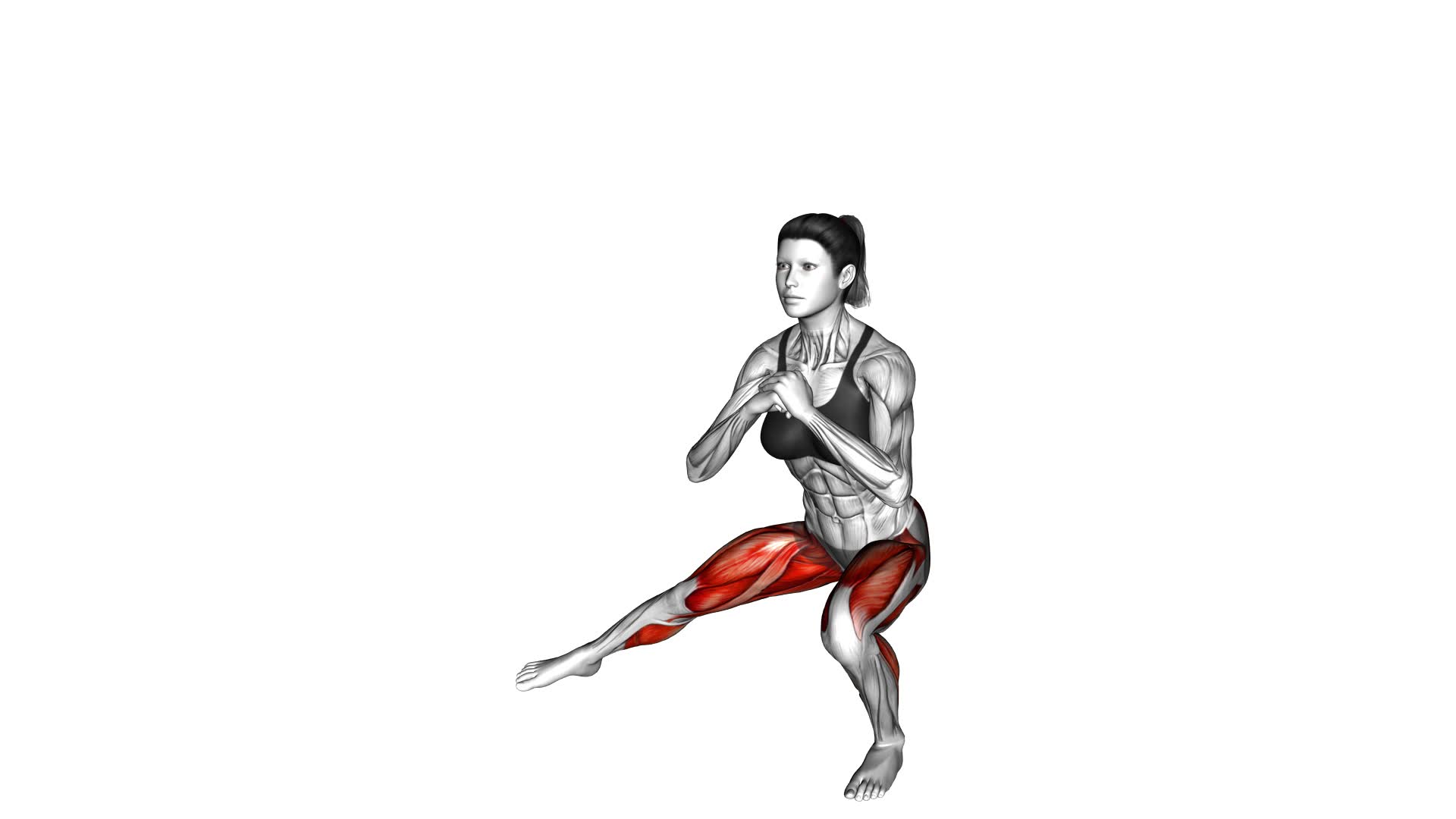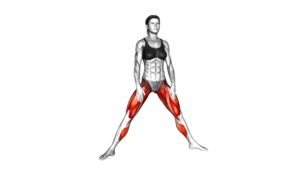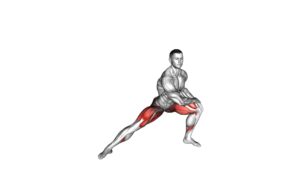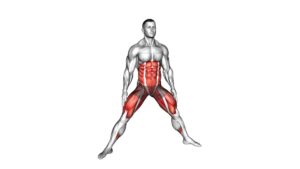Side Lunge Stretch (female) – Video Exercise Guide & Tips

Are you looking to improve your flexibility and strengthen your legs?
Watch This Exercise Video
Then the side lunge stretch is the perfect exercise for you!
In this video exercise guide, we'll show you how to properly perform the side lunge stretch, along with helpful tips and modifications.
Don't worry, we've got you covered!
Get ready to take your fitness to the next level with this effective and easy-to-follow exercise.
Let's get started!
Key Takeaways
- The Side Lunge Stretch improves flexibility in the hips and legs.
- It strengthens multiple muscle groups in the lower body, including the hip adductors, hip abductors, quadriceps, and hamstrings.
- This stretch helps to increase range of motion in the hips and lengthen and loosen muscles in the lower body.
- It also activates the inner and outer thigh muscles, improves balance and stability, and relieves tension in the lower back.
Benefits of the Side Lunge Stretch
By performing the side lunge stretch, you can improve flexibility and strengthen your lower body muscles. This stretch primarily targets the hip adductors, hip abductors, quadriceps, and hamstrings. The side lunge stretch helps to lengthen and loosen these muscles, allowing for improved flexibility and range of motion in the hips and legs.
When you perform the side lunge stretch, you activate multiple muscle groups in the lower body. The hip adductors, located on the inner thighs, are engaged as you step out to the side and lower into the lunge position. This activation helps to strengthen these muscles and improve their flexibility.
Additionally, the hip abductors, located on the outer hips, are also activated during the side lunge stretch. These muscles work to stabilize the hips and allow for smooth and controlled movement during the stretch. Strengthening the hip abductors can help to improve balance and prevent injuries.
Furthermore, the quadriceps and hamstrings, located in the front and back of the thighs, respectively, are also engaged during the side lunge stretch. These muscles are responsible for extending and flexing the knees, and by activating them, you can strengthen and tone these important muscle groups.
Proper Form and Technique
To perform the side lunge stretch with proper form and technique, follow these steps:
- Start by standing with your feet hip-width apart and your hands on your hips.
- Take a wide step to the side with your right foot, keeping your toes pointing forward.
- Bend your right knee and lower your body into a lunge position, making sure to keep your left leg straight.
- Keep your chest lifted and your core engaged throughout the movement.
- Hold the stretch for 20-30 seconds, then return to the starting position.
- Repeat the stretch on the other side.
Common misconceptions about the side lunge stretch include leaning too far forward or rounding the back. It's important to maintain an upright posture and engage your core to avoid strain on the lower back.
Precautions and safety measures should be taken when performing the side lunge stretch. If you have knee or hip issues, it's advisable to consult with a healthcare professional before attempting this exercise. Additionally, start with a smaller range of motion and gradually increase it as your flexibility improves.
With proper form and technique, the side lunge stretch can help improve hip flexibility and strengthen the inner thigh muscles.
In the next section, we'll explore modifications and variations of this exercise to suit different fitness levels and goals.
Modifications and Variations
Continuing from the previous subtopic, you can modify and vary the side lunge stretch to suit your fitness level and goals. Here are some alternative exercises and variations that you can try:
- Sumo Squat: Stand with your feet wider than hip-width apart and toes turned out. Lower your body into a squat position, keeping your knees in line with your toes. This exercise targets similar muscles as the side lunge stretch.
- Goblet Side Lunge: Hold a dumbbell or kettlebell with both hands in front of your chest. Take a wide step to the side and lower your body into a lunge, keeping your chest lifted. This variation adds more resistance to the exercise.
- Resistance Band Side Lunge: Place a resistance band around your thighs, just above your knees. Take a wide step to the side and lower your body into a lunge, pushing against the resistance of the band.
- Weighted Side Lunge: Hold a dumbbell or kettlebell in one hand, allowing it to hang down by your side. Take a wide step to the side and lower your body into a lunge, keeping the weight close to your body.
- Elevated Side Lunge: Stand on an elevated surface, such as a step or a sturdy platform. Take a wide step to the side and lower your body into a lunge, allowing your elevated foot to hang off the edge.
No equipment is needed for the side lunge stretch, but if you want to add resistance or intensity, you can use dumbbells, kettlebells, or resistance bands.
Common Mistakes to Avoid
As you progress in your side lunge stretch, it's important to be aware of common mistakes that can hinder your form and effectiveness of the exercise.
One common mistake to avoid isn't maintaining proper technique. It's crucial to ensure that your knees are aligned with your toes while performing the side lunge. Allowing your knees to collapse inward can put strain on your joints and increase the risk of injury.
Another mistake to avoid isn't keeping your back straight. It's important to engage your core muscles and keep your spine in a neutral position throughout the exercise. Slouching or rounding your back can reduce the effectiveness of the stretch and potentially cause back pain.
Lastly, be mindful of the depth of your lunge. Going too deep into the lunge can put excessive stress on your knees and hamstrings. It's important to find a comfortable range of motion that allows you to maintain proper form.
Tips for Getting the Most Out of Your Side Lunge Stretch
To maximize the benefits of your side lunge stretch, focus on these tips:
- Warm up: Before attempting any stretching exercises, it's important to warm up your muscles. This increases blood flow and prepares your body for the stretch, improving flexibility and reducing the risk of injury.
- Engage your core: Throughout the side lunge stretch, remember to engage your core muscles. This helps stabilize your body and allows for a deeper stretch, increasing range of motion.
- Keep your back straight: It's crucial to maintain a straight back during the side lunge stretch. This ensures proper alignment of the spine and prevents strain on the lower back.
- Use proper form: Pay attention to your form while performing the side lunge stretch. Keep your knees in line with your toes and lower your body as far down as comfortable, without straining. This will help you achieve a more effective stretch.
- Breathe deeply: Remember to breathe deeply and relax while holding the side lunge stretch. Deep breathing helps relax the muscles and allows for a greater stretch, improving flexibility.
Frequently Asked Questions
How Often Should I Perform the Side Lunge Stretch?
To get the most out of the side lunge stretch, it's important to perform it regularly. By incorporating it into your workout routine, you can experience the many benefits it offers.
The side lunge stretch helps improve flexibility in your hips, groin, and inner thighs. It also strengthens your leg muscles and increases your range of motion.
To keep things interesting, you can try different variations of the side lunge stretch to target different muscle groups.
Can the Side Lunge Stretch Help Improve Flexibility in Other Areas of the Body?
To improve balance and increase leg strength, the side lunge stretch can be beneficial.
By regularly performing this stretch, you can enhance flexibility not only in your legs but also in other areas of your body.
The side lunge stretch targets multiple muscle groups, helping to improve overall flexibility and range of motion.
Incorporating this stretch into your routine will contribute to a more well-rounded and flexible body.
Is It Safe to Perform the Side Lunge Stretch if I Have Knee or Hip Issues?
If you have knee or hip issues, it's important to be cautious when performing the side lunge stretch. The exercise can place strain on these areas and potentially worsen your condition.
It's best to consult with a healthcare professional before attempting this stretch. They can provide guidance on modifying the exercise or recommending alternative stretches that will promote knee health and improve hip flexibility without causing further harm.
Can the Side Lunge Stretch Help Alleviate Lower Back Pain?
To alleviate lower back pain, the side lunge stretch can be beneficial.
By incorporating this stretch into your routine, you can improve your posture and increase flexibility in your hips and lower back.
This stretch targets the muscles in your inner thighs, hamstrings, and glutes, which can help relieve tension in the lower back.
Remember to start slowly and listen to your body to avoid any discomfort or strain.
Can I Incorporate the Side Lunge Stretch Into My Pre-Workout Warm-Up Routine?
Incorporating the side lunge stretch into your pre-workout warm-up routine is a great idea. It can help improve your overall flexibility and prepare your muscles for the workout ahead. The side lunge stretch targets your inner thighs, hips, and groin, giving them a good stretch.
Conclusion
In conclusion, the side lunge stretch is a beneficial exercise for improving flexibility and strengthening the lower body.
By maintaining proper form and technique, you can maximize the effectiveness of this stretch.
It's important to avoid common mistakes and make modifications as needed to suit your fitness level.
Remember to listen to your body and gradually increase the intensity of the stretch over time.
With these tips, you can get the most out of your side lunge stretch and achieve your fitness goals.

Author
Years ago, the spark of my life’s passion ignited in my mind the moment I stepped into the local gym for the first time. The inaugural bead of perspiration, the initial endeavor, the very first surge of endorphins, and a sense of pride that washed over me post-workout marked the beginning of my deep-seated interest in strength sports, fitness, and sports nutrition. This very curiosity blossomed rapidly into a profound fascination, propelling me to earn a Master’s degree in Physical Education from the Academy of Physical Education in Krakow, followed by a Sports Manager diploma from the Jagiellonian University. My journey of growth led me to gain more specialized qualifications, such as being a certified personal trainer with a focus on sports dietetics, a lifeguard, and an instructor for wellness and corrective gymnastics. Theoretical knowledge paired seamlessly with practical experience, reinforcing my belief that the transformation of individuals under my guidance was also a reflection of my personal growth. This belief holds true even today. Each day, I strive to push the boundaries and explore new realms. These realms gently elevate me to greater heights. The unique combination of passion for my field and the continuous quest for growth fuels my drive to break new ground.







